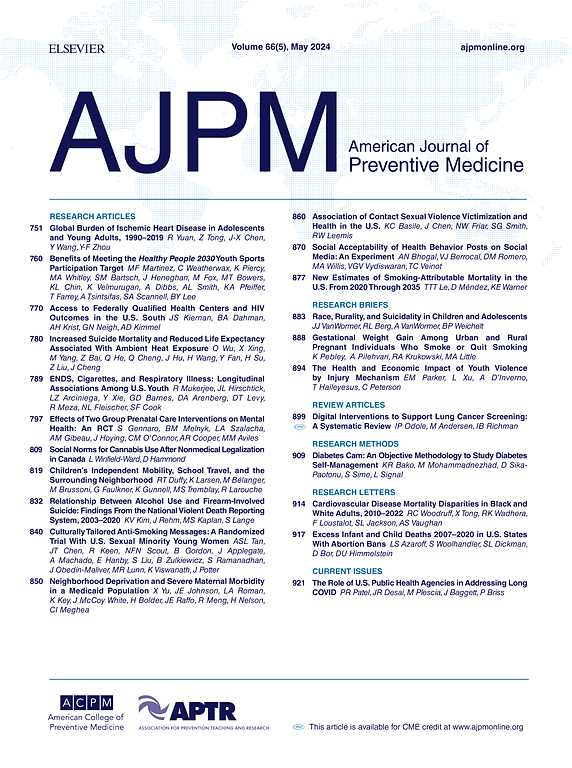联邦卡路里菜单标签政策与全国快餐连锁店中餐馆购买的卡路里:一项准实验研究。
IF 4.5
2区 医学
Q1 MEDICINE, GENERAL & INTERNAL
引用次数: 0
摘要
简介:2018年5月,联邦政府强制要求在菜单上标注标签,但作者并不知道有任何工作使用比较组来评估这项立法在全国范围内对餐馆的影响,以解释潜在的偏见。方法:采用综合控制方法,将全国标签后实施菜单标签的塔可钟餐厅(n= 5060家餐厅)与当地标签立法后(在全国标签之前)在菜单上添加卡路里标签的餐厅进行匹配。使用双向固定效应回归模型估计在全国范围内标签组(即“后处理”和“早处理”餐厅)之间,菜单标签对每笔交易的卡路里购买的影响,时间模型为实施后的相对月份,固定效应为日历月和餐厅。结果:在基线期,国家菜单标签组的每笔交易平均卡路里为1242 (SD=178),对照组的每笔交易平均卡路里为1245 (SD=183.9),两组之间的趋势相似。差异中的差异模型结果表明,来自全国菜单标签组的餐馆的交易包括7.4 (95% CI: 7.3, 7.5)卡路里比基于对照组趋势的预测多。全国菜单标注组的月平均交易次数比对照组多减少了2%。结论:由于国家立法,在增加卡路里标签的餐馆中,购买的卡路里和交易数量的变化可以忽略不计,超出了长期变化。其他策略可能是必要的,以促进有意义的减少每天在餐馆购买的卡路里。本文章由计算机程序翻译,如有差异,请以英文原文为准。
Federal Calorie Menu Labeling Policy and Calories Purchased in Restaurants in a National Fast Food Chain: A Quasi-Experimental Study
Introduction
Menu labels were federally mandated in May 2018; however, to the authors’ knowledge, no study has evaluated the impact of the national rollout of this legislation in restaurants using a comparison group to account for potential bias.
Methods
Using synthetic control methods, Taco Bell restaurants that implemented menu labels after nationwide labeling (n=5,060 restaurants) were matched to restaurants that added calorie labels to menus after local labeling legislation (and before nationwide labeling). The effect of menu labeling on calories purchased per transaction after nationwide labeling between groups (i.e., “later-treated” and “early-treated” restaurants) was estimated using a 2-way fixed effects regression model, with time modeled as relative month from implementation and fixed effects for calendar month and restaurant.
Results
In the baseline period, average calories per transaction was 1,242 (SD=178) in the national menu labeling group and 1,245 (SD=183.9) in the comparison group, with parallel trends between groups. Difference-in-differences model results indicated that transactions from restaurants in the national menu labeling group included 7.4 (95% CI=7.3, 7.5) more calories than that was predicted based on the trend in the comparison group. The average number of total transactions per month decreased ∼2% more in the national menu labeling group than in the comparison group.
Conclusions
Negligible changes were observed in calories purchased and number of transactions in restaurants that added calorie labels because of national legislation, above and beyond secular changes. Other strategies may be necessary to promote meaningful decreases in daily calories purchased in restaurants in the future.
求助全文
通过发布文献求助,成功后即可免费获取论文全文。
去求助
来源期刊

American Journal of Preventive Medicine
医学-公共卫生、环境卫生与职业卫生
CiteScore
8.60
自引率
1.80%
发文量
395
审稿时长
32 days
期刊介绍:
The American Journal of Preventive Medicine is the official journal of the American College of Preventive Medicine and the Association for Prevention Teaching and Research. It publishes articles in the areas of prevention research, teaching, practice and policy. Original research is published on interventions aimed at the prevention of chronic and acute disease and the promotion of individual and community health.
Of particular emphasis are papers that address the primary and secondary prevention of important clinical, behavioral and public health issues such as injury and violence, infectious disease, women''s health, smoking, sedentary behaviors and physical activity, nutrition, diabetes, obesity, and substance use disorders. Papers also address educational initiatives aimed at improving the ability of health professionals to provide effective clinical prevention and public health services. Papers on health services research pertinent to prevention and public health are also published. The journal also publishes official policy statements from the two co-sponsoring organizations, review articles, media reviews, and editorials. Finally, the journal periodically publishes supplements and special theme issues devoted to areas of current interest to the prevention community.
 求助内容:
求助内容: 应助结果提醒方式:
应助结果提醒方式:


